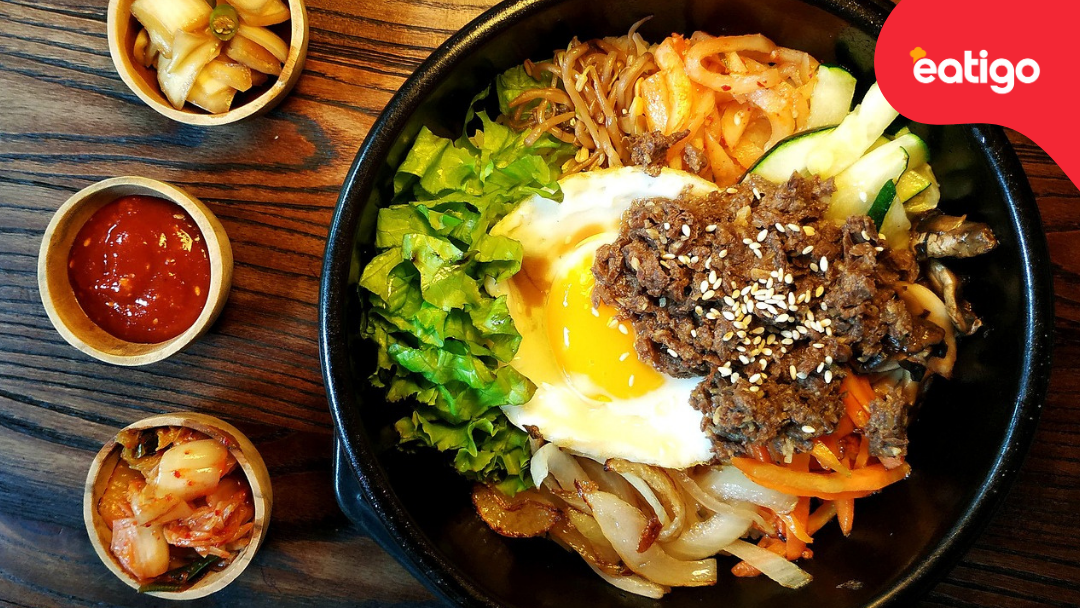15 Classic Korean food – enjoy specialities dishes

Top 20 Best omakase in kl (October update 2025)
September 30, 2024
What is omakase? Explained by master
October 1, 2024Welcome to our exploration of classic Korean food, where we dive into the rich flavors and unique specialties that define this beloved cuisine! From the spicy kick of kimchi to the savory goodness of bulgogi, Korean dishes are known for their vibrant ingredients and delightful combinations.
Recommend Classic Korean food
Whether you’re a longtime fan or new to Korean Food, join us as we celebrate the traditional recipes and must-try specialties that make dining Korean an unforgettable experience!
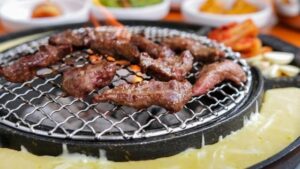
1.Galbi
Galbi, also known as “kalbi,” is a popular Korean dish that consists of marinated beef short ribs. The ribs are typically marinated in a mixture of soy sauce, sugar, garlic, sesame oil, and other ingredients, which gives them a rich, savory flavor. After marinating, the ribs are usually grilled or barbecued, resulting in a tender, juicy texture and a slightly caramelized exterior.
Galbi is often served with various side dishes (banchan), such as kimchi and pickled vegetables, and is commonly enjoyed with steamed rice. It can be prepared in different styles, including using a grill or a stovetop, and is a favorite at Korean barbecues.
2.Galbi Tang
Galbi Tang is a traditional Korean soup made with beef short ribs (galbi) that are simmered until tender. The dish typically includes a flavorful broth made from the ribs, along with ingredients like radish, garlic, green onions, and sometimes other vegetables. It’s known for its rich, hearty flavor and is often enjoyed with rice and various side dishes (banchan). Galbi Tang is especially popular in colder months, as it’s warm and comforting.
3.Samgyetang
Samgyetang is a traditional Korean soup featuring a whole young chicken stuffed with glutinous rice, ginseng, garlic, and other herbs. The chicken is simmered until tender, resulting in a rich and flavorful broth. This dish is often enjoyed during the hot summer months, as it’s believed to help replenish energy and strengthen the body. Samgyetang is not only comforting but also regarded as a health-boosting dish in Korean cuisine. It’s commonly served with a side of salt for seasoning and sometimes enjoyed with kimchi.
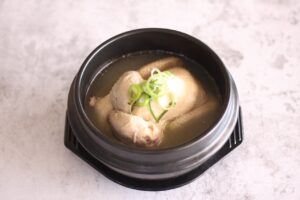
4.Kimchi Jjigae
Kimchi Jjigae is a popular Korean stew made primarily with kimchi, tofu, pork (or sometimes tuna), and a variety of vegetables. The dish is known for its spicy, tangy flavor, derived from the fermented kimchi, which is cooked down to create a rich broth. Often, it includes ingredients like garlic, green onions, and gochugaru (Korean red pepper flakes) for added heat. Kimchi Jjigae is a comforting and hearty dish, typically served hot and enjoyed with steamed rice. It’s a staple in many Korean households and is often made with leftover kimchi, making it both delicious and practical!
5.Bossam
Bossam is a traditional Korean dish that consists of boiled pork, typically served with a variety of accompaniments. The pork is usually cooked until tender and then sliced, and it’s often served with napa cabbage leaves, which are used to wrap the meat. Diners can add garlic, chili pepper, and a dollop of ssamjang (a thick, savory dipping sauce) to their wraps for extra flavor.
Bossam is often enjoyed during celebrations and gatherings and is known for its rich, savory taste and the interactive dining experience it offers. It’s also popular to serve with side dishes like kimchi and pickled radishes.
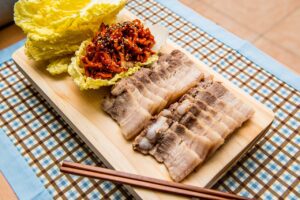
6.Chap Chae
Chap Chae is a popular Korean dish made from stir-fried glass noodles (made from sweet potato starch) mixed with a variety of vegetables, meat (often beef or chicken), and sometimes eggs. The dish is seasoned with soy sauce, sesame oil, and garlic, giving it a savory and slightly sweet flavor.
The noodles are known for their chewy texture and are typically combined with ingredients like carrots, spinach, mushrooms, and onions, making it colorful and nutritious. Chap Chae is often served as a side dish or a main course and is enjoyed both hot and cold. It’s a staple at celebrations and gatherings in Korean cuisine.
7.Mandoo
Mandoo are Korean dumplings that can be filled with a variety of ingredients, including ground meat (like pork or beef), vegetables, and sometimes tofu or seafood. They can be prepared in several ways: steamed, boiled, pan-fried, or deep-fried, each offering a different texture and flavor.
Mandoo are often served with a dipping sauce made from soy sauce, vinegar, and sesame oil. They can be enjoyed as a snack, appetizer, or main dish and are particularly popular during holidays and special occasions. There are many regional variations of mandoo, reflecting different ingredients and cooking methods across Korea.
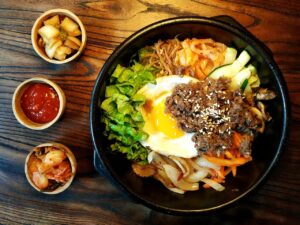
8.Bulgogi
Bulgogi is a popular Korean dish made from marinated beef that is grilled or stir-fried. The marinade typically consists of soy sauce, sugar, sesame oil, garlic, and pepper, giving the beef a sweet and savory flavor. The meat is usually thinly sliced, which helps it absorb the marinade and cook quickly.
Bulgogi can be served on its own, with rice, or wrapped in lettuce leaves, often accompanied by side dishes like kimchi. It’s a favorite for barbecues and is loved for its tender texture and rich taste. There are variations of bulgogi that use different meats, but beef bulgogi is the most common.
9.Dongchimi
Dongchimi is a type of Korean kimchi that is made with radishes, particularly the crunchy white radish known as “mu.” It is a watery, mild, and refreshing kimchi, often enjoyed during the colder months. The preparation involves soaking the radish in a brine made of water, salt, garlic, and sometimes a bit of ginger and chili pepper.
Dongchimi is typically served as a side dish and can be enjoyed on its own or as a flavorful broth with rice. It’s especially popular for its crisp texture and slightly tangy taste, providing a nice contrast to richer dishes. The fermentation process gives it a subtle sourness, making it a refreshing addition to a Korean meal.
10.Bibimbap
Bibimbap is a classic Korean dish that translates to “mixed rice.” It typically consists of a bowl of steamed rice topped with a variety of sautéed and seasoned vegetables, such as spinach, carrots, and mushrooms, along with sliced or minced meat (commonly beef).
A key feature of bibimbap is the addition of a fried egg, usually placed on top, and it’s often served with gochujang (Korean red chili paste) for added flavor and spice. Before eating, diners mix all the ingredients together, creating a colorful and flavorful combination. Bibimbap is not only delicious but also visually appealing, making it a popular choice in Korean cuisine. There are many regional variations, and it can be served cold or hot, such as in the stone bowl version called “dolsot bibimbap,” which creates a crispy rice layer at the bottom.
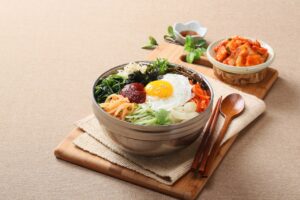
11.Kimchi
Kimchi is a traditional Korean side dish made from fermented vegetables, most commonly napa cabbage and Korean radish, seasoned with a variety of spices and ingredients. The main ingredients typically include garlic, ginger, red pepper flakes (gochugaru), fish sauce, and salt. The fermentation process gives kimchi its distinct tangy flavor and probiotic properties, making it a staple in Korean cuisine.
There are many varieties of kimchi, ranging from mild to spicy, and it can include other vegetables like scallions or cucumbers. Kimchi is not only served as a side dish but also used in various dishes, such as kimchi jjigae (kimchi stew) and kimchi fried rice. It’s celebrated for its bold flavors and health benefits, being rich in vitamins and beneficial bacteria.
12.Tteokbokki
Tteokbokki is a popular Korean street food dish made primarily from chewy rice cakes (tteok) that are stir-fried in a sweet and spicy sauce. The sauce typically contains gochujang (Korean red chili paste), which gives it a distinctive heat and flavor, along with ingredients like sugar, soy sauce, and garlic.
Tteokbokki is often accompanied by fish cakes, boiled eggs, and green onions, and sometimes topped with sesame seeds. It has a satisfying, slightly sticky texture and is beloved for its combination of sweet, spicy, and savory flavors. Often found at food stalls and in casual eateries, tteokbokki is a favorite comfort food in Korea and has gained popularity around the world.
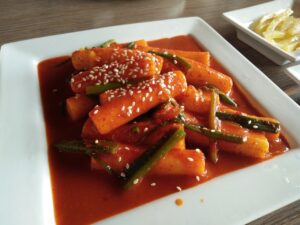
13.Jajangmyeon
Jajangmyeon is a popular Korean dish featuring wheat noodles topped with a savory black bean sauce called “jajang.” The sauce is made from fermented black soybeans, diced pork or other proteins, and various vegetables like onions, zucchini, and sometimes potatoes.
The dish is known for its rich, slightly sweet flavor and is often served with sliced cucumbers or pickled radish for contrast. Jajangmyeon is a favorite comfort food in Korea and is commonly enjoyed on special occasions, especially during holidays. It’s also widely available at Korean restaurants and is often paired with other dishes like “tangsuyuk,” or sweet and sour pork.
14.Samgyeopsal
Samgyeopsal is a popular Korean dish consisting of thick slices of pork belly that are grilled at the table. The name translates to “three-layered meat,” referring to the three layers of fat and meat in the pork belly.
Typically, the pork is cooked until crispy and tender, and diners often enjoy it wrapped in lettuce leaves with accompaniments like garlic, green peppers, and a dollop of ssamjang (a savory dipping sauce).
Samgyeopsal is not just a dish but also a social experience, often enjoyed during gatherings or barbecues with friends and family. It’s commonly served with side dishes (banchan) like kimchi and pickled vegetables, making for a hearty and interactive meal.
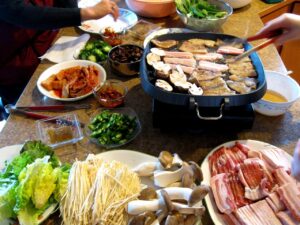
15.Sundae
Sundae is a traditional Korean dish that consists of blood sausage made from a mixture of pig’s blood, sweet rice, and various ingredients, such as glass noodles, garlic, and spices. The mixture is stuffed into a casing, usually made from the intestines of the pig, and then steamed or boiled.
Sundae is often served sliced, accompanied by a dipping sauce, and is commonly enjoyed with side dishes like kimchi. It’s a popular street food and is often found at markets and food stalls in Korea. There are regional variations of sundae, with some using different ingredients or spices, but it is generally known for its unique flavor and chewy texture.
Summary
Whether you’re a devoted fan or just discovering Korean cuisine, come along as we honor the classic recipes and essential dishes that make dining Korean truly unforgettable!

